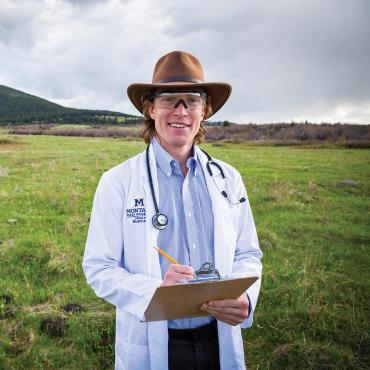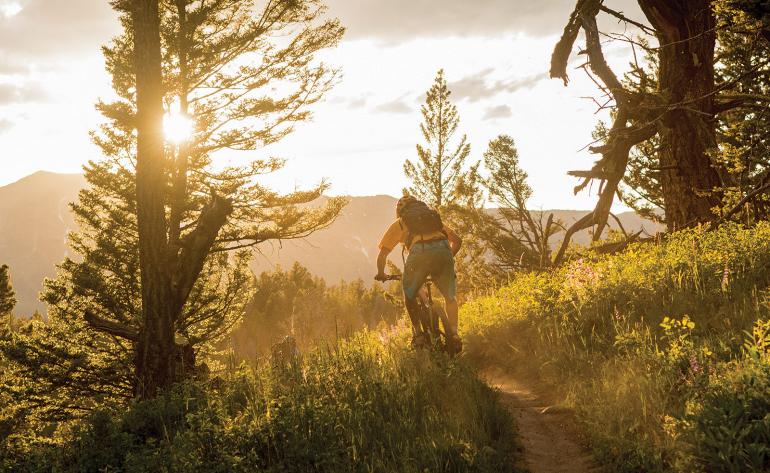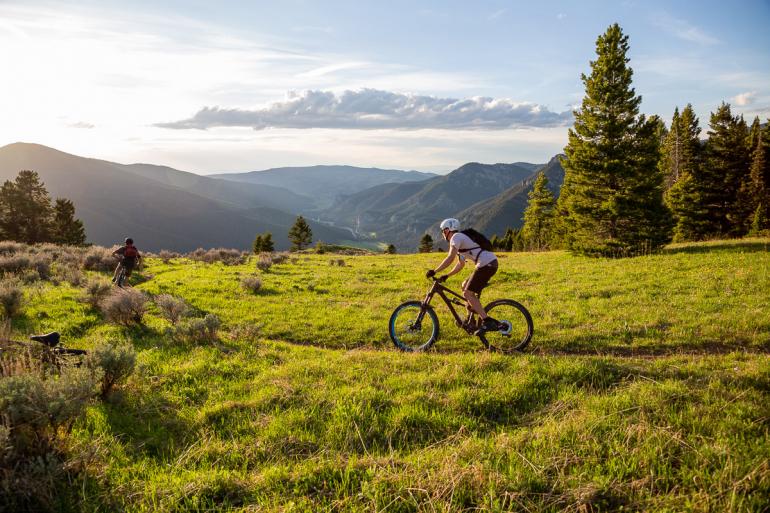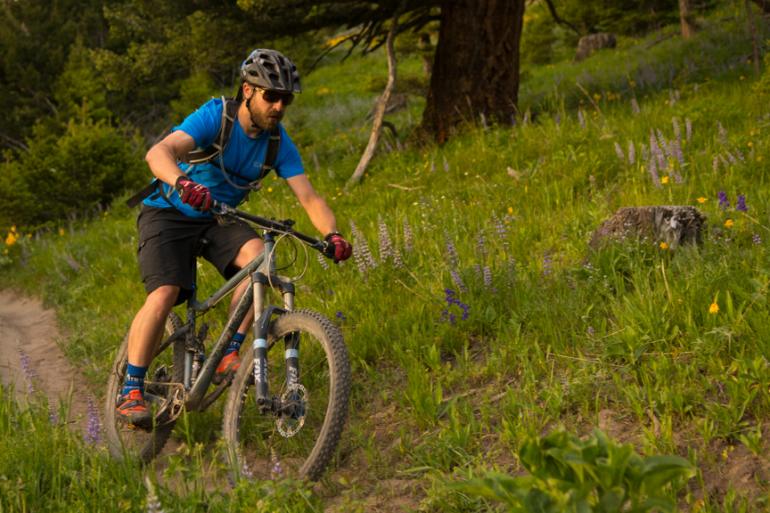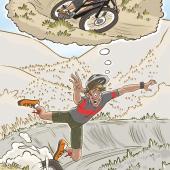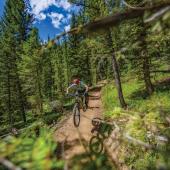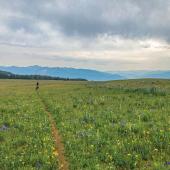Chain Gang
Managing Bozeman's biking surge.
With 800 miles of trails to manage and many different user groups to accommodate, the Bozeman Ranger District has a lot on its plate. But recreation is just one part of the picture. The Forest Service takes a holistic approach to managing our public lands, weighing impacts on wildlife, timber resources, cultural heritage sites, and wetlands. As more and more users flock to the Bozeman District’s trails each year, our rangers and recreation managers are working hard to adapt. In particular, the surging popularity of mountain biking in Bozeman over the past decade has called for a look at the trails from a different angle, raising discussions on new trail components, such as loops and man-made features, to accommodate two-wheeled enthusiasts.
To better understand the situation, we talked with two members of the Bozeman District’s staff about their approach to maintaining our trails, and the considerations for new trail proposals. Melissa Simpson started working as the district’s Recreation Program Manager this past fall after 15 years with the Forest Service in the north woods of Michigan, and enjoys family rides out at Copper City. Wendi Urie has been serving the Bozeman District for over 20 years, and loves riding the Bangtail Divide in June when the wildflowers are going off, to take in the smell of lupine.
O/B: Wendi, you’ve been around town for a while. How has the mountain-biking scene in Bozeman changed since you first got involved with the Forest Service?
Wendi: Growth in Bozeman has been happening the whole time I’ve been here, and mountain biking is becoming more popular along with it. One change I’ve noticed over the last decade in particular is that we now have a well-organized biking club. When I first started working in Bozeman over 20 years ago, there wasn’t a cohesive mountain-biking group. People weren’t really working together. But Southwest Montana Mountain Bike Association (SWMMBA) has really taken that partnership to a new level. They help us organize volunteer events, and give lots of trail information to our field crew. They share the trail mantra, and in any user group, people receive input better from their peers than from a government agency.
Melissa: And we have limited staff at the Forest Service—we’re getting pulled in so many different directions with all sorts of recreation. SWMMBA has provided a lot of volunteers for trail maintenance, which is the biggest category of volunteerism in the Forest Service. It’s nice to have that volunteer base throughout the season.
O/B: What is the process when deciding if new trails should be developed?
Wendi: The process is guided by our Travel Plan, which has a big public-review component. But it’s a bit dated now—it was slated in 2006. So quite frankly, we haven’t added a trail that wasn’t part of that plan since then. And a lot of the new construction that was part of the Travel Plan has been on the motorized side, to build more sustainable motorized trails.
O/B: Do you think the trails included in the Travel Plan will be enough to accommodate Bozeman’s population growth, or will we need to consider expanding that trail network in the near future?
Melissa: Right now, we’re focusing on maintaining our existing system. We have hundreds of miles of trails already; taking care of that is a lot of effort. And it also takes a lot of effort when we look at expanding trailheads, or building new connectors, or expanding areas that are approved in the Travel Plan. One thing that’s unique about the Forest Service is that we’re interdisciplinary, so it’s not just about recreation. We involve our wildlife biologists, botanists, archaeologists, engineers, and minerals specialists to make sure we’re taking care of all the resources. On the recreation side, we’re providing expertise on what’s sustainable for a trail system, and what the users want. It’s not an easy, “Hey, field crew, let’s build a new trail or connector.” It’s a really big planning process.
Wendi: Even within recreation, we have to consider all of our users: motorized, non-motorized, summer, winter. A discussion about more trails for a particular user group garners interest from all types of people, and that adds complications to the process. When we drafted our Travel Plan, we talked about the need for loops on motorized trails—going out-and-back wasn’t what people were looking for. But we didn’t go there in the non-motorized world, and we need to start looking at that. So many of our bike routes are also popular hikes. They’re one way in, one way out, and that adds to the conflict. If we create some loop systems, it may help. We’re looking for a way to carve out capacity, and SWMMBA wants to take on a project with us.
O/B: Do you think there’s an argument for designating certain trails specifically for mountain biking, and not for foot traffic?
Wendi: We often get proposals like this, especially around trails like Leverich. We have to remember that the more we create single-use trails, the less there is for everybody. There are 800 miles of trail in the Bozeman District. We can’t have 800 miles of different trails for each specific usage; we need to share them. On Leverich, the uphill side is a great place to walk or run, as well as bike. I don’t see us moving toward single-use; our mantra is multi-use. Things like high-speed, one-way, downhill, bike-only trails are more appropriate for places like Big Sky, where the activity is managed commercially.
O/B: What are the biggest impacts of trail-building on the ecology of a forest?
Wendi: We’re looking at everything from wildlife disturbances, to archaeology and heritage sites, to soil impacts. Some places are just more fragile than others. Lately, we’ve been paying a lot of attention to wildlife, and moving forward, that’ll be a big part of the discussion. Fast-moving recreation has become a bigger part of the discussion, especially regarding grizzly bears. That’s a big consideration.
O/B: Does mountain biking have a greater impact on trails than other uses?
Wendi: It’s hard to quantify the difference in impacts. Actually, horses, especially on wet ground, can have a fair amount of impact, and also motorcycles, with so much torque on the back wheel. You’ll see that on the Bangtail Divide; we’re trying to harden those switchbacks on the Grassy Mountain end. But it has more to do with volume of use. The M trail takes a lot of maintenance because so many pilgrims are going up and down it each day. Groups like SWMMBA spend a lot of time maintaining trails like the downhill on Leverich. That particular trail is unique to the Bozeman District: it’s the only trail we have that’s built for speed, and it’s not sustainably built from an erosion standpoint.
O/B: Do you think the trails included in the Travel Plan will be enough to accommodate Bozeman’s population growth, or will we need to consider expanding that trail network in the near future?
Melissa: Right now, we’re focusing on maintaining our existing system. We have hundreds of miles of trails already; taking care of that is a lot of effort. And it also takes a lot of effort when we look at expanding trailheads, or building new connectors, or expanding areas that are approved in the Travel Plan. One thing that’s unique about the Forest Service is that we’re interdisciplinary, so it’s not just about recreation. We involve our wildlife biologists, botanists, archaeologists, engineers, and minerals specialists to make sure we’re taking care of all the resources. On the recreation side, we’re providing expertise on what’s sustainable for a trail system, and what the users want. It’s not an easy, “Hey, field crew, let’s build a new trail or connector.” It’s a really big planning process.
Wendi: Even within recreation, we have to consider all of our users: motorized, non-motorized, summer, winter. A discussion about more trails for a particular user group garners interest from all types of people, and that adds complications to the process. When we drafted our Travel Plan, we talked about the need for loops on motorized trails—going out-and-back wasn’t what people were looking for. But we didn’t go there in the non-motorized world, and we need to start looking at that. So many of our bike routes are also popular hikes. They’re one way in, one way out, and that adds to the conflict. If we create some loop systems, it may help. We’re looking for a way to carve out capacity, and SWMMBA wants to take on a project with us.
O/B: Do you think there’s an argument for designating certain trails specifically for mountain biking, and not for foot traffic?
Wendi: We often get proposals like this, especially around trails like Leverich. We have to remember that the more we create single-use trails, the less there is for everybody. There are 800 miles of trail in the Bozeman District. We can’t have 800 miles of different trails for each specific usage; we need to share them. On Leverich, the uphill side is a great place to walk or run, as well as bike. I don’t see us moving toward single-use; our mantra is multi-use. Things like high-speed, one-way, downhill, bike-only trails are more appropriate for places like Big Sky, where the activity is managed commercially.
O/B: What are the biggest impacts of trail-building on the ecology of a forest?
Wendi: We’re looking at everything from wildlife disturbances, to archaeology and heritage sites, to soil impacts. Some places are just more fragile than others. Lately, we’ve been paying a lot of attention to wildlife, and moving forward, that’ll be a big part of the discussion. Fast-moving recreation has become a bigger part of the discussion, especially regarding grizzly bears. That’s a big consideration.
O/B: Does mountain biking have a greater impact on trails than other uses?
Wendi: It’s hard to quantify the difference in impacts. Actually, horses, especially on wet ground, can have a fair amount of impact, and also motorcycles, with so much torque on the back wheel. You’ll see that on the Bangtail Divide; we’re trying to harden those switchbacks on the Grassy Mountain end. But it has more to do with volume of use. The M trail takes a lot of maintenance because so many pilgrims are going up and down it each day. Groups like SWMMBA spend a lot of time maintaining trails like the downhill on Leverich. That particular trail is unique to the Bozeman District: it’s the only trail we have that’s built for speed, and it’s not sustainably built from an erosion standpoint.

